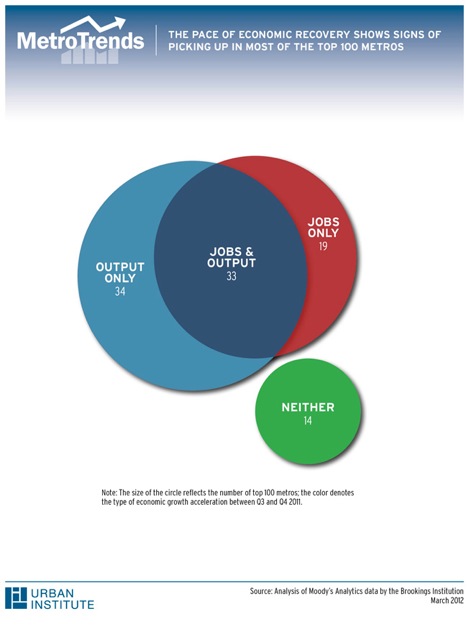
|
|
MetroMonitor MetroMonitor: Tracking Economic Recession and Recovery in America's 100 Largest Metropolitan Areas (1st Quarter 2012)The rate of output growth accelerated in 67 of the 100 largest metropolitan areas between the third and fourth quarters of 2011 while the rate of job growth accelerated in 52 metropolitan areas. Both nationwide and in the 100 largest metropolitan areas combined, the rates of job growth and output growth rose between the third and fourth quarters of 2011. However, there was substantial variation among the 100 largest metropolitan areas. Thirty-four metropolitan areas, including a number of high technology centers (Austin, Boise, Boston, Minneapolis, Ogden, and Worcester), Great Lakes manufacturing centers (Akron, Detroit, Grand Rapids, Milwaukee, Toledo, and Youngstown), metropolitan areas hit hard by the housing crisis (Boise, Cape Coral, Detroit, Lakeland, Phoenix, Sacramento, and Tampa), and five of the six large metropolitan areas in Texas (Austin, Dallas, El Paso, Houston, and San Antonio) saw accelerating output growth but slowing job growth. Both job and output growth rates accelerated in 33 metropolitan areas, including several that were hit hard by the housing crisis (Bakersfield, Jacksonville, Miami, North Port, Orlando, Palm Bay, and Tucson) and many other metropolitan areas in the South (Atlanta, Baton Rouge, Charlotte, Columbia, Greensboro, Jackson, Knoxville, Little Rock, McAllen, Memphis, Nashville, Raleigh, and Richmond). In 19 of the nation's largest metropolitan areas, job growth accelerated but output growth slowed between the third and fourth quarters of the year; these included most of the California and Nevada metropolitan areas hit hard by the housing crisis (Fresno, Las Vegas, Los Angeles, Modesto, Riverside, San Diego, and Stockton) and several metropolitan areas in the Northeast and mid-Atlantic (Allentown, Baltimore, Bridgeport, Lancaster, New Haven, Philadelphia, and Scranton). In 14 large metropolitan areas, including several high technology centers (Albany, Oxnard, Provo, San Francisco, San Jose, and Washington), both employment and output grew more slowly in the fourth quarter than in the third quarter. For more see the Brookings Institution MetroMonitor |
Experts Feedback
Send us your comments to help further the discussion. Share
Commentaries
|




